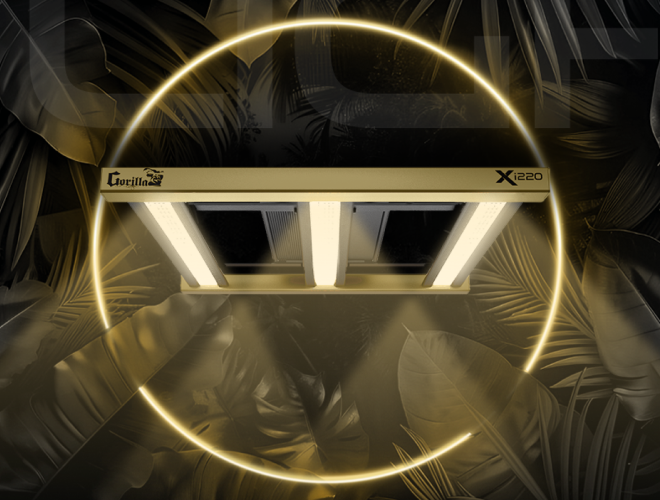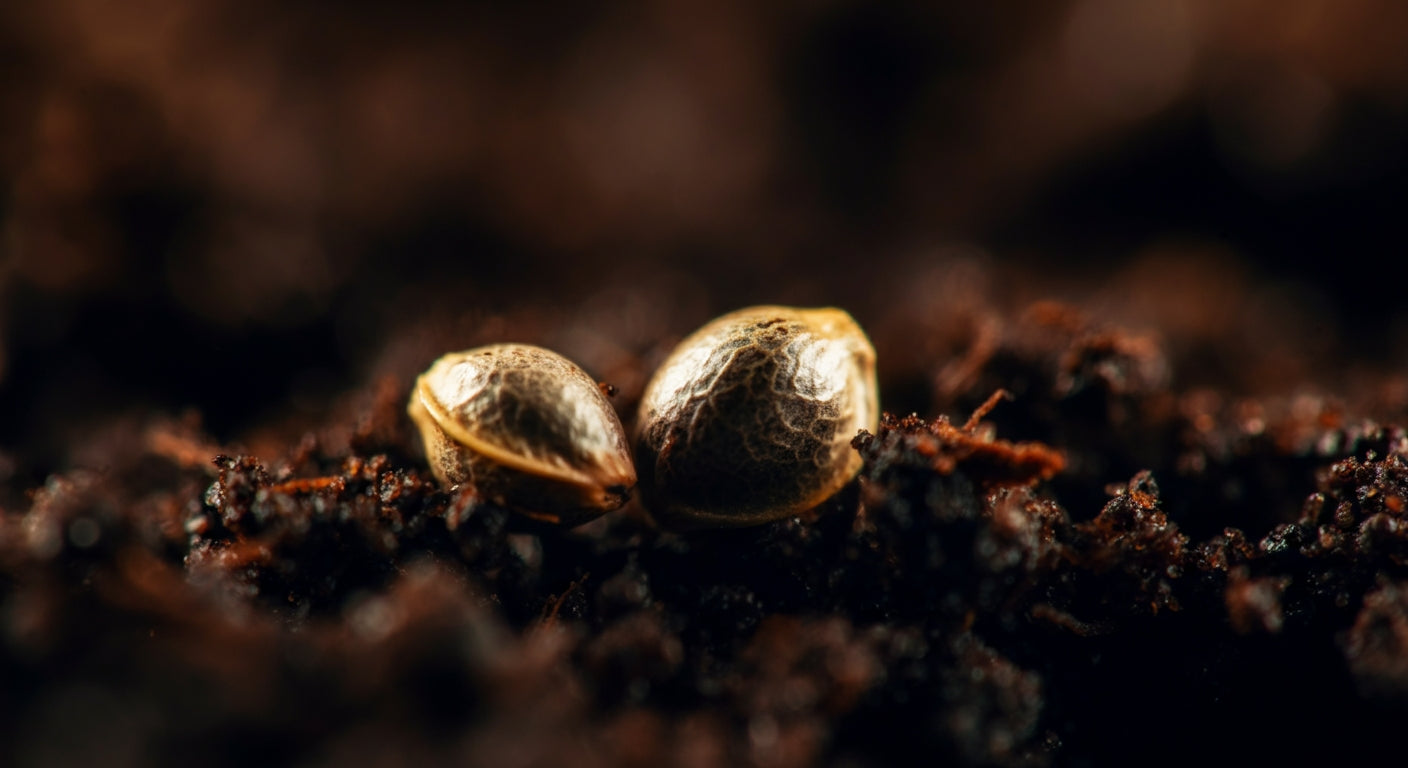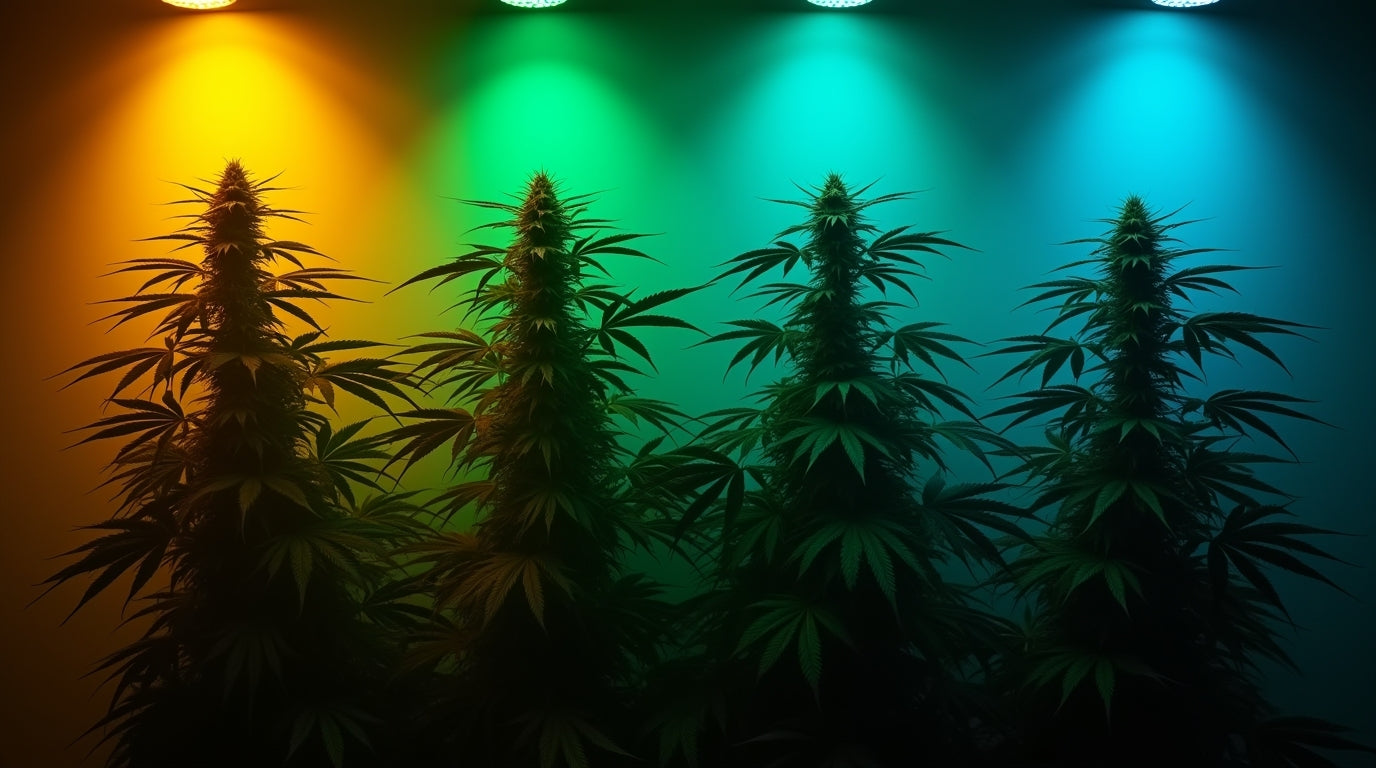
Cannabis Grow Lights: The Complete Guide to LED Lighting for Maximum Cannabis Yields
Cannabis grow lights represent the single most important equipment investment for indoor cultivation success. The right lighting system can mean the difference between mediocre harvests and exceptional yields, making proper light selection crucial for any serious cannabis grower.
Modern LED technology has revolutionized cannabis cultivation by providing precise spectrum control, energy efficiency, and heat management that traditional lighting systems cannot match. Understanding how to select, install, and optimize cannabis-specific grow lights ensures your plants receive the exact wavelengths needed for vigorous growth and potent bud development.
Whether you're upgrading from older lighting technology or building your first cannabis grow, this comprehensive guide covers everything needed to select and implement the perfect lighting solution for maximum cannabis yields and quality.
Why Cannabis Requires Specialized Grow Lights
Cannabis Light Requirements vs. Other Plants
Cannabis plants have unique photosynthetic needs that differ significantly from typical houseplants or vegetables, requiring specialized lighting systems designed for high-intensity cultivation.
Cannabis-Specific Light Needs:
- High Light Intensity: Cannabis thrives under much higher PPFD levels than most plants
- Spectrum Flexibility: Different growth stages require dramatically different light spectrums
- Photoperiod Sensitivity: Precise light timing triggers flowering in photoperiod strains
- Deep Canopy Penetration: Dense cannabis canopies need strong light penetration for lower bud development
Understanding PPFD for cannabis becomes critical as cannabis requires 400-1500+ μmol/m²/s depending on growth stage and CO2 levels.
Cannabis Growth Stages and Lighting Requirements
Each stage of cannabis development demands specific lighting conditions to optimize growth rates and final harvest quality.
Seedling Stage (Weeks 1-3):
- PPFD Requirements: 200-400 μmol/m²/s for gentle development
- Spectrum Needs: Higher blue light ratio for compact growth
- Photoperiod: 18-24 hours daily for continuous development
- Optimal PPFD for seedlings ensures healthy establishment without stress
Vegetative Stage (Weeks 4-12):
- PPFD Requirements: 400-600 μmol/m²/s for vigorous growth
- Spectrum Needs: Blue-dominant spectrum promotes leafy growth
- Photoperiod: 18-24 hours daily maintains vegetative state
- Growth Optimization: Higher light intensities accelerate development
Flowering Stage (Weeks 13-25):
- PPFD Requirements: 600-1500 μmol/m²/s for maximum bud production
- Spectrum Needs: Red-dominant spectrum triggers and supports flowering
- Photoperiod: Strict 12/12 schedule for photoperiod varieties
- Quality Focus: Optimal lighting maximizes potency and yield

Best LED Grow Lights for Cannabis in 2025
Modern LED technology has reached new heights of efficiency and spectrum control, making LED systems the clear choice for serious cannabis cultivation.
Why LED Lights Dominate Cannabis Growing
Can LED lights help plants grow effectively? The answer is definitively yes, especially for cannabis cultivation where LED technology provides unmatched advantages.
LED Advantages for Cannabis:
- Energy Efficiency: 40-50% less electricity than HID systems
- Heat Management: Minimal heat production enables closer plant positioning
- Spectrum Control: Precise wavelength targeting for each growth stage
- Longevity: 50,000+ hour lifespan reduces replacement costs
- Dimming Capability: Adjustable intensity prevents light stress
Best Full Spectrum LED Grow Lights for Cannabis
Full spectrum LED systems provide the complete wavelength range cannabis needs throughout its entire lifecycle, eliminating the need for multiple light types.
Full Spectrum Benefits:
- Complete Coverage: All wavelengths from 380-800nm available
- Growth Stage Flexibility: One light handles seedling through harvest
- Natural Sun Simulation: Mimics outdoor growing conditions
- Enhanced Quality: Full spectrum improves terpene and cannabinoid production
Top Cannabis LED Recommendations:
Xi220 LED Grow Light: Perfect for small cannabis operations
- Coverage: 2x2 to 2x3 feet optimal coverage
- Power: 220W actual draw with high efficiency
- Features: Full spectrum with enhanced red for flowering
- Best For: 1-2 cannabis plants in compact spaces
Xi330 LED Grow Light: Ideal for medium cannabis grows
- Coverage: 3x3 feet optimal flowering coverage
- Power: 330W with premium Samsung diodes
- Features: Advanced spectrum control and dimming
- Best For: 2-4 cannabis plants in standard tents
Xi420 LED Grow Light: Professional cannabis cultivation
- Coverage: 4x4 feet for maximum production
- Power: 420W with exceptional PPFD delivery
- Features: Tri-channel spectrum control and wireless connectivity
- Best For: 4-6 cannabis plants for serious yields
Xi750 LED Grow Light: Commercial-grade cannabis growing
- Coverage: 5x5 feet for large operations
- Power: 750W for maximum light intensity
- Features: Advanced cooling and precision control
- Best For: 6-9 cannabis plants for maximum harvests
Cannabis Lighting Spectrum Requirements
Understanding Cannabis Photobiology
Cannabis responds differently to various light wavelengths, making spectrum optimization crucial for maximizing both growth rates and final harvest quality.
Blue Light (400-500nm) Benefits:
- Vegetative Growth: Promotes compact, leafy development
- Stem Strength: Creates stronger plant structure
- Trichome Production: Enhances resin development
- Pest Resistance: Improves plant defense mechanisms
Red Light (600-700nm) Benefits:
- Flowering Trigger: Initiates and maintains flowering response
- Bud Development: Maximizes flower size and density
- Energy Efficiency: Most efficient wavelength for photosynthesis
- Yield Enhancement: Directly correlates with harvest weight
Far-Red Light (700-800nm) Applications:
- Stretch Control: Manages internode spacing
- Flowering Speed: Can accelerate flowering transition
- Canopy Penetration: Improves light distribution through dense foliage
- Harvest Timing: Influences maturation speed
UV Light (280-400nm) Benefits:
- Potency Enhancement: Increases THC and terpene production
- Stress Response: Triggers beneficial plant stress responses
- Quality Improvement: Enhances cannabinoid profiles
- Pest Deterrent: Natural insect and disease resistance
LED Grow Light Distance and Positioning
Proper positioning of cannabis grow lights ensures optimal PPFD delivery while preventing light burn or stress that can reduce yields and quality.
Grow Light Distance Chart for Cannabis
Understanding optimal LED positioning requires considering power output, growth stage, and environmental conditions.
Cannabis LED Distance Guidelines:
| Growth Stage | Low Power (100-200W) | Medium Power (200-400W) | High Power (400W+) |
|---|---|---|---|
| Seedlings | 24-30 inches | 30-36 inches | 36-42 inches |
| Vegetative | 18-24 inches | 24-30 inches | 30-36 inches |
| Early Flower | 16-20 inches | 20-26 inches | 26-32 inches |
| Late Flower | 14-18 inches | 18-24 inches | 24-30 inches |
Distance Adjustment Factors:
- Environmental Control: Better cooling allows closer positioning
- Plant Response: Monitor for light stress or stretching
- CO2 Levels: Higher CO2 enables closer light placement
- Strain Characteristics: Sativa varieties may need greater distance
How to Install LED Grow Lights for Cannabis
Proper installation ensures optimal performance while maintaining safety and flexibility for height adjustments throughout the grow cycle.
Installation Best Practices:
- Structural Support: Ensure tent or ceiling can support light weight
- Adjustable Hanging: Use rope ratchets for easy height changes
- Heat Consideration: Position for optimal air circulation
- Coverage Planning: Center lights over growing area for even distribution

PPFD and DLI Requirements for Cannabis
Importance of High PPFD in Cannabis Cultivation
Cannabis is a high-light plant that responds dramatically to increased PPFD levels, making light intensity optimization crucial for maximum yields.
Cannabis PPFD Requirements by Stage:
Seedling Stage PPFD:
- Range: 200-400 μmol/m²/s for healthy establishment
- Duration: 18-24 hours daily
- DLI Target: 15-25 mol/m²/day
- Key Focus: Avoid light stress while promoting development
Vegetative Stage PPFD:
- Range: 400-600 μmol/m²/s for vigorous growth
- Duration: 18-24 hours daily
- DLI Target: 25-40 mol/m²/day
- Growth Optimization: Higher levels accelerate development
Flowering Stage PPFD:
- Range: 600-1500 μmol/m²/s for maximum production
- Duration: 12 hours daily (strict schedule)
- DLI Target: 35-65 mol/m²/day
- Yield Maximization: Higher levels directly increase harvest weight
Daily Light Integral (DLI) for Cannabis
DLI represents the total amount of photosynthetic light cannabis plants receive over 24 hours, directly correlating with growth rates and final yields.
Calculating Cannabis DLI:
- Formula: PPFD × photoperiod hours × 3.6 ÷ 1,000,000
- Example: 800 PPFD × 12 hours × 3.6 ÷ 1,000,000 = 34.6 DLI
- Optimization: Higher DLI generally produces better results
- Limits: Environmental factors limit maximum beneficial DLI
Environmental Factors Affecting DLI Tolerance:
- CO2 Levels: Higher CO2 enables higher DLI utilization
- Temperature: Optimal temps (75-85°F) improve light efficiency
- Humidity: Proper VPD enhances photosynthetic efficiency
- Air Movement: Good circulation prevents heat stress
Cannabis Lighting Systems Comparison
LED vs. Traditional Lighting for Cannabis
Modern LED technology has largely replaced traditional lighting systems for cannabis cultivation due to superior efficiency and control capabilities.
LED vs. HPS Comparison:
| Factor | LED Grow Lights | HPS Lights |
|---|---|---|
| Energy Efficiency | 2.5-3.0 μmol/J | 1.5-1.7 μmol/J |
| Heat Production | Minimal | Significant |
| Spectrum Control | Full customization | Fixed spectrum |
| Lifespan | 50,000+ hours | 10,000-20,000 hours |
| Initial Cost | Higher | Lower |
| Operating Cost | Lower | Higher |
LED vs. CMH Comparison:
| Factor | LED Grow Lights | CMH (LEC) Lights |
|---|---|---|
| Efficiency | Superior | Good |
| Heat Management | Excellent | Moderate |
| Spectrum Quality | Customizable | Natural |
| Maintenance | Minimal | Bulb replacement |
| Coverage | Even distribution | Hotspot patterns |
Emerging Cannabis Lighting Technologies
Quantum Board LEDs: Distribute diodes across large boards for even coverage COB LEDs: Concentrated diodes providing intense point-source lighting Bar-Style LEDs: Linear fixtures offering superior heat dissipation UV Supplementation: Specialized UV LEDs for potency enhancement
Optimizing Cannabis Light Schedules
Photoperiod Management for Different Cannabis Types
Photoperiod Cannabis Scheduling:
- Vegetative: 18-24 hours light maintains growth phase
- Flowering Trigger: Switch to 12/12 initiates flowering
- Flowering Maintenance: Strict 12/12 schedule prevents revegetation
- Light Leak Prevention: Complete darkness during night periods essential
Autoflowering Cannabis Scheduling:
- Consistent Schedule: 18-24 hours throughout lifecycle
- No Photoperiod Changes: Plants flower based on age, not light schedule
- Energy Considerations: 20-hour schedule balances growth and efficiency
- Strain Variations: Some autos prefer specific light schedules
Advanced Lighting Strategies
Progressive Light Intensity: Gradually increase PPFD as plants mature Spectrum Ramping: Adjust blue/red ratios throughout growth stages Light Cycling: Short dark periods can enhance certain metabolic processes Harvest Light Stress: Brief high-intensity exposure before harvest may boost potency
Common Cannabis Lighting Mistakes
Avoiding Costly Light-Related Errors
Light Burn and Stress:
- Symptoms: Bleached or yellow leaves, especially near lights
- Causes: Excessive PPFD or lights positioned too close
- Prevention: Monitor plant response and adjust accordingly
- Solutions: Increase distance or reduce intensity immediately
Insufficient Light Penetration:
- Symptoms: Lower buds remain small and airy
- Causes: Inadequate light intensity or poor distribution
- Prevention: Choose appropriate wattage for grow space
- Solutions: Add supplemental lighting or improve positioning
Spectrum Imbalances:
- Vegetative Issues: Too much red causes stretching
- Flowering Problems: Insufficient red reduces bud development
- Prevention: Use full-spectrum lights or proper spectrum control
- Solutions: Adjust spectrum ratios or supplement deficient wavelengths
Cannabis Lighting Setup Examples
Complete Lighting Solutions by Grow Size
Small Cannabis Setup (2x2 tent, 1-2 plants):
- Light: Xi220 LED Grow Light
- PPFD: 400-800 μmol/m²/s across coverage area
- Power Draw: 220W for energy efficiency
- Height Range: 18-30 inches depending on growth stage
Medium Cannabis Setup (3x3 tent, 2-4 plants):
- Light: Xi330 LED Grow Light
- PPFD: 500-1000 μmol/m²/s for optimal yields
- Power Draw: 330W with premium efficiency
- Features: Advanced dimming and spectrum control
Large Cannabis Setup (4x4 tent, 4-6 plants):
- Light: Xi420 LED Grow Light
- PPFD: 600-1200 μmol/m²/s for maximum production
- Power Draw: 420W with exceptional coverage
- Technology: Wireless control and environmental integration
Commercial Cannabis Setup (5x5+ area, 6+ plants):
- Light: Xi750 LED Grow Light or multiple units
- PPFD: 800-1500 μmol/m²/s for commercial yields
- Power Draw: 750W+ for large-scale operations
- Scalability: Multiple units for expanded coverage

Environmental Integration with Cannabis Lighting
Coordinating Lights with Environmental Systems
Heat Management:
- LED Advantages: Minimal heat production compared to HID systems
- Ventilation Coordination: Sync exhaust fans with light schedules
- Temperature Control: Maintain 75-85°F during lights-on periods
- Seasonal Adjustments: Adapt cooling/heating based on ambient conditions
Humidity Control:
- Light-Related Transpiration: Higher PPFD increases plant water uptake
- VPD Optimization: Balance temperature and humidity for efficient photosynthesis
- Dehumidification: May need increased capacity during high-intensity periods
- Air Circulation: Enhanced airflow prevents humidity pockets
CO2 Supplementation with High-Intensity Lighting
CO2 Benefits with LED:
- Increased PPFD Tolerance: Higher CO2 enables 1200-1500 μmol/m²/s PPFD
- Enhanced Photosynthesis: Improved light conversion efficiency
- Yield Increases: 20-30% yield improvements possible
- Environmental Requirements: Sealed environment necessary for effectiveness
Measuring and Monitoring Cannabis Light Performance
Essential Light Measurement Tools
PAR Meters: Measure actual PPFD reaching plant canopies Light Meters: Provide basic lux measurements for general reference Smartphone Apps: Convenient but less accurate alternatives Professional Meters: Laboratory-grade instruments for precise measurement
Measurement Best Practices:
- Multiple Points: Take readings across entire growing area
- Canopy Level: Measure at actual plant height
- Regular Monitoring: Check levels as lights age and plants grow
- Documentation: Record measurements for optimization tracking
Performance Optimization Strategies
Light Distribution Mapping: Create PPFD maps to identify coverage patterns Efficiency Tracking: Monitor electricity usage vs. yield outcomes Spectrum Analysis: Use spectroradiometers for precise wavelength measurement Plant Response Monitoring: Track growth rates and development patterns
Future of Cannabis Lighting Technology
Emerging Technologies and Trends
Smart Lighting Systems: AI-driven spectrum and intensity optimization Wireless Integration: Seamless environmental system coordination Efficiency Improvements: Next-generation diodes exceeding 3.0 μmol/J Spectrum Innovations: Precise wavelength targeting for specific outcomes
Sustainability Focus: Solar integration and reduced environmental impact Automation Advances: Hands-off lighting management systems Quality Enhancement: Specialized spectrums for cannabinoid optimization Cost Reductions: Continued price decreases making LED accessible
FAQ Section
What are the best grow lights for cannabis?
LED grow lights are currently the best choice for cannabis cultivation, offering energy efficiency, spectrum control, and minimal heat production. The Xi series LED lights provide optimal performance for different grow sizes.
How much PPFD do cannabis plants need?
Cannabis requires high PPFD levels: 200-400 μmol/m²/s for seedlings, 400-600 μmol/m²/s for vegetative growth, and 600-1500 μmol/m²/s for flowering stage depending on environmental conditions.
How far should LED grow lights be from cannabis plants?
LED distance varies by growth stage: 24-36 inches for seedlings, 18-30 inches for vegetative growth, and 14-24 inches for flowering, depending on light wattage and plant response.
Can you use regular LED lights to grow cannabis?
No, regular household LEDs cannot effectively grow cannabis. Cannabis requires specialized full-spectrum grow lights with appropriate intensity and spectrum ratios for successful cultivation.
What light schedule is best for cannabis?
Photoperiod cannabis needs 18-24 hours light for vegetative growth and exactly 12 hours light/12 hours darkness for flowering. Autoflowering varieties can receive 18-24 hours light throughout their lifecycle.
Summary
Bottom Line: Cannabis grow lights are the foundation of successful indoor cultivation, with modern LED technology providing unmatched efficiency, spectrum control, and yield potential when properly selected and implemented for cannabis-specific requirements.
Investing in quality cannabis lighting systems pays dividends through increased yields, improved quality, and reduced operating costs. Understanding PPFD requirements, spectrum optimization, and proper positioning ensures your lighting investment delivers maximum returns.
Maximize Your Cannabis Yields with Professional Lighting
Transform your cannabis cultivation with lighting systems engineered specifically for maximum yields and quality. Gorilla Grow Tent's Xi Series LED lights provide everything needed for professional cannabis growing, from compact 220W systems for small operations to powerful 750W units for commercial-scale cultivation.
Whether you're upgrading from older technology or building your first complete cannabis grow setup, our full-spectrum LED systems deliver the precise wavelengths and intensities cannabis needs for exceptional results. With professional PPFD output, intelligent spectrum control, and lifetime growing support, you'll achieve consistently outstanding harvests that justify your lighting investment.
Don't let inadequate lighting limit your cannabis potential. Browse our complete selection of cannabis grow lights and professional growing systems to build the perfect setup for maximum yields and premium quality. Join thousands of successful cannabis growers who trust Gorilla LED technology for consistently exceptional results, harvest after harvest.

Lena Myles
I'm a mushroom enthusiast and home cook based in Oregon. I'm passionate about foraging and creating fungi-focused recipes, especially delicious, plant-based dishes using gourmet mushrooms like trumpet, shiitake, and oyster. When I’m not in the kitchen, you’ll usually find me wandering the woods in search of new wild flavors.


